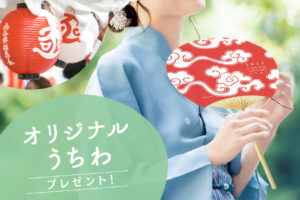
PR
Arashiyama is one of the most scenic spots in Kyoto. This area has long been a favorite place for aristocrats and powerful people in the capital to enjoy the cherry blossoms and autumn foliage as a place for a separate business (villa).
But,A lonely place outside of Kyoto where foxes, raccoon dogs, and ghosts dwell when the sun goes downBut there was.Some people called Arashiyama "Ayashiyama.That's what it means.
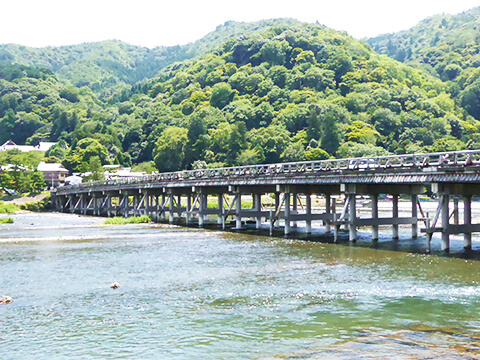
Speaking of Arashiyama, Togetsu Bridge
The following legend, based on fact, still exists in Arashiyama.
In 1500, Emperor Go-Tsuchimikado died, and during the period of mourning, killing was forbidden. A fisherman who fished along the Hozu River began to send rafts upstream to Arashiyama until the mourning period was over. The fisherman had a son who had gone to work for a merchant family. However, the son fell in love with the owner's daughter, shaved his head, and went to live in hiding in a dilapidated mido (temple) upstream on the Hozu River.
One day, the son sees his beloved daughter walking into the back of the temple and follows her like a madman. But what he finds there is a statue of Kannon, the Goddess of Mercy, who looks exactly like his daughter. He tries to convince himself that the statue is his daughter, but eventually despairs and throws himself into the Hozu River.
Meanwhile, the fishing season was lifted and the fishermen began casting nets into the river again. The fishermen were delighted to find a response they had never experienced before. The fishermen were delighted to find that they had caught a big fish, and they were astonished when they hauled in their nets. The net contained the corpse of his son, who was holding an image of the Goddess of Mercy, Avalokitesvara.
Richard Gordon Smith, a naturalist who came to Japan from England in 1898, also wrote about this legend as having collected it during his stay in Japan, but he did not describe the location where the body of the fisherman's son was found. The only thing I can think of is that it was probably in this area,Chidorigafuchi" on the right bank of the Hozugawa River in ArashiyamaIt is.
For the first time in a long time, we made our way to Chidorigafuchi. We crossed the Watarigibashi bridge, turned right, and walked along the Hozugawa River to Daihikaku.
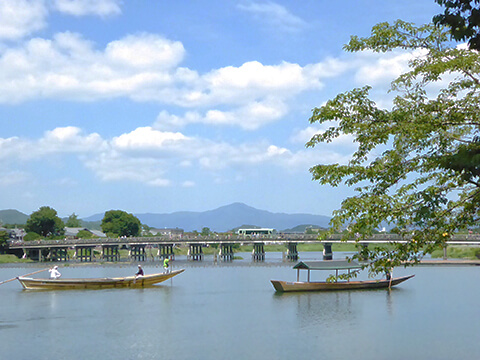
View of the Togetsu Bridge from the walking path to Daihikaku.
After a short distance, there is an uphill slope, and at the end of the descent, a rock face spreads out along the riverbank. This area has long been called "Chidorigafuchi," a famous spot behind Arashiyama.
This abyss,The place where Yokobue, a maid of honor of Kenreimonin of Taira no Kiyomori, is said to have thrown herself at the end of the Heian period (794-1185).It is also a legend that dates back 1,000 years. The reason why it cannot be dismissed as a 1,000-year-old legend is that even in the Showa period (1926-1989), there were whispered rumors of a "suicide spot," and many people threw themselves into this abyss one after another.
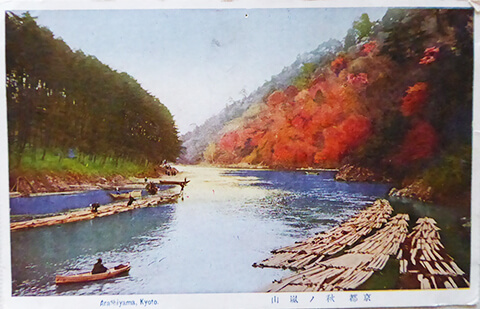
Postcards of the Chidorigafuchi area from the end of the Taisho era to the beginning of the Showa era (in the possession of the author)
It was about 10 years ago. During our interview, we had the opportunity to talk to an elderly woman who used to run a tea store on this Chidorigafuchi beach.
The old woman had saved people from drowning in the river three times when she ran a tea store. According to local residents, the water is extremely deep only in this area, and the current has lost its momentum due to the topography. The bottom of the river is said to be swirling, and when a body is caught in the water, it is difficult for it to rise to the surface, and when it does, it is often deadly wax. It is said that when photographed facing the surface of the abyss, the ripples of the water look like a person's face. ......
When I visited Chidorigafuchi 10 years ago, the water surface was covered with overgrown tree branches, accentuating the gloomy atmosphere. The area near the Togetsu Bridge was submerged by heavy rains three years ago and has since been renovated.
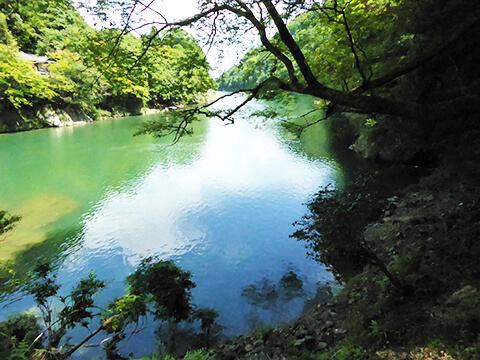
Chidorigafuchi (fountainhead)
Just,The brighter the sunlight, the darker the shade.It is a thing of the past. It is perhaps one of the deepest aspects of Kyoto that, while the city is bustling with tourist attractions, there are also behind-the-scenes attractions where sad legends and horrific events lurk.
Tradition that exists everywhere in the city of Kyoto. It is not just a picture, it is secretly alive in this modern age and continues to coexist with people. The two of Office TO, who previously wrote a series of articles "Kyoto's Demon World Exploration" in the monthly magazine Leaf, explore the mysterious "different" world of Kyoto, which was created over 1200 years. I will unravel the story while actually visiting the place. .
 News
News Feature article
Feature article Featured event
Featured event